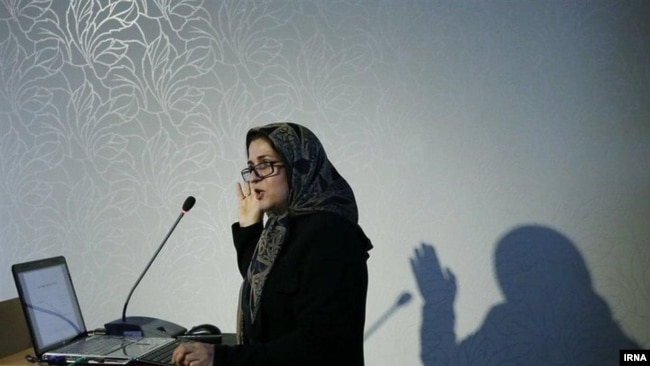Radiofarda – Several Iranian and dual national demographers have been reportedly arrested during the past weeks, less than a year after Ian’s security forces arrested dozens of environmentalists on charges of espionage and “corruption on earth”.
These are serious accusations that could mean the death sentence for the victims. Some believe this is related to Islamic Republic’s ideological and security paranoia, while others say it is simply a policy of detaining dual nationals as bargaining chips.
It is not even clear when exactly the arrests took place. Tehran media began mentioning the news in late November.
One of those arrested, Meymanat Hosseini Chavoshi, is an Iranian demographer who works with the Australian National University as a Researcher and one of the authors of the book Developments in Fertility in Iran (2010). She is also a co-author of Population Developments in Iran, a research book sponsored by the Iranian President’s Strategic Studies Center in 2017.
The research published in association with the Iranian Demographic Society was an assessment of developments in the Iranian population and their relationship with the country’s economy and labor market.
Iranian newspapers that have reported Ms. Chavoshi’s arrest at the airport before leaving Iran have described her as an “infiltrator,” adding that she was arrested by “anonymous soldiers of the hidden Imam,” which is Iranian hardliners’ jargon for intelligence officers.

New Charge Carrying Death Penalty Confirmed Against Environmentalists
The unprecedented charges brought against the demographers, “social espionage” is a new fabrication that has no precedence even in Iran’s own legal system.
Meanwhile human rights organizations based outside Iran have named others including a man Iranian media briefly identified as M.A. According to the International Campaign for Human Rights in Iran, Mohammad Jalal Abbasi, who is a professor of demography at the Tehran University is likely to be the man named by hardline media in Tehran as another one of the detainees.
However, hardline media outlets such as the Kayhan newspaper, Fars News agency and Mashregh news website have said that several university professors have been arrested as part of the demographers’ case.
The way the case is being treated is similar to how the Iranian intelligence organization and hardline media handled the environmentalists’ case. At the same time, the paranoia and heavy-handed approach highlights the difficulties involved in academic efforts within the frameworks of an ideological religious government, says Paris-based Iranian sociologist Saeed Peyvandi, in a commentary on Radio Farda’s Persian website.
The case is also reminiscent of Iranian intelligence services’ suspicion of dual nationals who return to Iran for academic research or simply a visit to their families.
Recently the family members of six of dual nationals languishing in Iranian jails without legal or other justifications, wrote a letter to world leaders and international human rights organizations explaining the ordeal of the prisoners and their families, calling for international attention to their cases.
Detailing individual cases of the six prisoners, the letter emphasizes that dual nationals arrested in Iran are taken hostage by Iranian authorities who want to use them as bargaining chips to solve their problems with international community. “The similarities between our loved ones’ cases is striking. Each story is not just a case of arbitrary detention, but deliberate and tactical moves by the Iranian authorities to secure bargaining chips,” stresses the letter.
Saeed Peyvandi, adds another dimension to the arrests, and asks why should scientific activity be treated by Iranian government as espionage, and opines that the answer might be in the attitude of Islamic Republic officials toward social developments and academic circles.
According to Peyvandi a silent revolution has been going on in the Iranian population since the 1990s. The annual population growth rate of 3.7% between 1976 and 1986 has plummeted to 1.25% . While prior to the 1979 revolution, the Iranian government was deeply concerned about the high growth rate in Iran’s population, the slowing down of the trend has annoyed Islamic Republic leaders.
Iran’s population grew from 33 million in 1976 to 60 million in 1996 to the current 82 million according to the Iranian statistical center, giving rise to concerns about the lack of a proportionate progress in the country’s economy, education, health, environment and the like.
Although population growth has slowed, it is not easy to deal with the needs of more than 80 million people with all the economic problems the Islamic Republic faces, says Peyvandi.
In the meantime, from a sociological point of view, the size of families has become smaller and birth rate has declined and the age of marriage gone up.
All this is in contradiction to Iran’s Supreme Leader Ayatollah Khamenei’s “vision” for increasing the population to his ideal 150 million. Based on that vision, former populist President Mahmoud Ahmadinejad promised a one million tuman gift in cash (around $1,000 at the time) for every child born. A promise never kept, and never embraced by the poorest strata of Iranian population who could be most susceptible to financial incentives.
As a result, the average fertility rate of 6 children per mother in 1979 declined to 1.8 in 2016 while there is also a growth in the number of individuals who decide to remain single. In the 2016 census, there were some 10 million single persons aged 20-39.
While it was difficult to challenge Khamenei’s ideological “vision” about population, demographers highlighted their opposition in different ways including mentioning economic and environmental problems.
Perhaps a major question to ask Khamenei is how can his Islamic Republic feed 150 million people and ensure their wellbeing while it is facing so many problems in satisfying basic needs of the current 80 million.
 Shabtabnews In this dark night, I have lost my way – Arise from a corner, oh you the star of guidance.
Shabtabnews In this dark night, I have lost my way – Arise from a corner, oh you the star of guidance.



